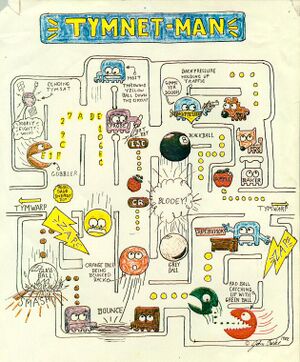Tymshare Base-Host Protocol
From Computer History Wiki
Revision as of 06:41, 28 April 2022 by Larsbrinkhoff (talk | contribs) (Updates from SRI-NIC Foonly F3.)
This documents the protocol, as used around 1975-1982, between a PDP-10 host and Varian 620 Tymbase.
Messages are transmitted from the PDP-10 as 36-bit words with four octets in bits 0-31. Bits 32-35 are unused.
Message types A, B, C, and D are just 4 octets.
| Message number | Port | Subtype or data | Data |
Type F messages total 8 octets:
| Message number | Port | Data | Data |
| Data | Data | Unused | Unused |
Type G messages have a variable number of octets. The message number is 200 (octal) plus the total number of octets in the message, including header.
| 200+n | Port | Data | Data |
| Data as per n | |||
| ... | |||
Messages. Any number not in this list is illegal. Numbers 1-41 were present in 1975. Numbers 42-61 was added around 1982.
| Number | Type | Name | Comment |
| 1 | A | ANS | System is answering. |
| 2 | A | SHT | System is up but shut. |
| 3 | A | CRS | Sender is crashed. |
| 4 | A | DIE | Recipient should crash. |
| 5 | A | NSP | Base taken over by new supervisor. |
| 6 | B | LOG | Login, next 4 data characters are the info about terminal type, and port or origin, then name, etc. |
| 7 | B | AUX | Supervisor response to establishing auxiliary circuit. |
| 10 | B | NOP | Back pressure on. |
| 11 | B | OUP | Back pressure off. |
| 12 | B | GOB | Character gobbler. |
| 13 | B | ZAP | Circuit zapper. |
| 14 | B | EDC | Enter deferred echo mode. |
| 15 | B | LDC | Leave deferred echo mode. |
| 16 | B | GRN | Green ball. |
| 17 | B | RED | Red ball. |
| 20 | B | YEL | Yellow ball. |
| 21 | B | ORG | Orange ball. |
| 22 | B | HNG | Hang character - not used. |
| 23 | B | ETM | Enter 2741 transparent mode. |
| 24 | B | LTM | Leave 2741 transparent mode. |
| 25 | C | LOS | Lost ball, data has been lost from buffers. The data filed may tell how many were lost. |
| 26 | C | SUP | Supervisor request (aux circuits). |
| 27 | C | SUR | Supervisor response (aux circuits). |
| 30 | C | AXC | Supervisor string character. |
| 31 | F | TSP | Test pattern probe. |
| 32 | F | TSR | Test pattern response. |
| 33 | F | SAD | Host sad. |
| 34 | B | ECN | Echo on. |
| 35 | B | ECF | Echo off. |
| 36 | D | TCS | Term characteristics, first data byte indicates which characteristics second data byte indicates value to set to. |
| 37 | C | TCP | Term characteristics probe, data byte indicates which terminal characteristic were requested. |
| 40 | D | TCR | Term characteristics response, data is just like TCS, comes in response to a probe; also is reflected by remote when terminal characteristics are sent. |
| 41 | C | HSI | Host up and answering with # of ports in port byte, and host # in data byte. |
| 42 | A | CLP | Super clock info request. |
| 43 | F | CLR | Super clock info. |
| 44 | H | BKO | Start block output. |
| 45 | B | BOC | Block ouptut complete. |
| 46 | H | BIN | Start block input. |
| 47 | D | INB | Block input done, out of buffer. |
| 50 | D | INE | Block input done, completed. |
| 51 | D | INT | Block input done, timeout. |
| 52 | B | IRQ | Requst block input termination. |
| 53 | D | IHR | Block input done, host request. |
| 54 | B | ORQ | Request block output termination. |
| 55 | B | OHR | Block output done, host request. |
| 56 | C | NEG | Block IO port negotiation. |
| 57 | B | BRK | Break character received. |
| 60 | C | PSR | Port status. |
| 61 | B | EAO | Enter alt output device mode. |
| 200+n | G | Data. |
This information comes from the SUMEX-AIM monitor file TYMSRV.MAC, written by Michael A. Heathman in 1975. Additional updates from the SRI-NIC version from 1982.
